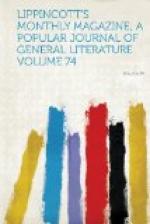[Illustration: NEGRO WAR-DANCE, OR CORROBORI.]
The Australians are extremely fond of dancing, especially their corrobori or war-dance, performed always with bodies perfectly nude, while they brandish a spear in one hand and a flaming brand in the other. The night is invariably selected for the performance of the corrobori, and the effect upon unaccustomed eyes is startling in the extreme. The agile movements of the lean forms, black as night, reflected by the radiance of their gleaming torches, the yells and frantic gestures, together with the fierce onsets of the combatants with spear and tomahawk, present a spectacle of weird interest, quite in keeping with the wild scenery of the defiles and ravines where the corrobori is usually celebrated.
[Illustration: A GOLD-MINE.]
The complexion of the Australians is black or very dark brown, their hair straight, and their features of the negro type. They are of medium stature, but generally thin, though well-formed, athletic and agile. They are eager in the pursuit of gain, and this characteristic, combined with their wonderful powers of endurance both of hunger and fatigue, renders them patient and successful miners, while all other causes combined have tended less to the development and improvement of the Australian than has the discovery of gold within his borders. This discovery, that has so changed the aspect of everything in Australia, was the result of a mere accident that a thinking mind knew how to turn to advantage. An adventurer from California, whose dreams by day and by night were all of the land of gold he had so recently left, while searching in company with another for a new pasturage-ground for their sheep, came one day upon a range of low hills so like the “Golden Range” of California as to bring back all his old prepossessions in favor of mining. Stopping to examine, he found the hills composed of granite, mica and quartz, the natural home of gold, and his experience as a miner led to the conviction that though the main body of the gold might have been already washed out among the surrounding clay, yet enough remained to repay a careful search and to indicate the existence, somewhere in the immediate vicinity, of a mine of untold wealth. Several days were spent in unprofitable search: then more favorable indications led the shepherds to dispose of their flocks and set out in good earnest to dig for gold. A couple of spades, a trowel and a calabash were their only tools, but our adventurer was a knowing man, and “knowledge is power.” His practiced eye knew just where the precious metals would be most likely to exist if at all in that locality—that in the old beds of rivers now dried up gold would more naturally be found than in younger streams, and especially that where round pebbles indicated a strong eddy ten times as much gold might be expected as in the level parts. Gravel and shingle were cleared away without examination, then a bed of gray clay,




